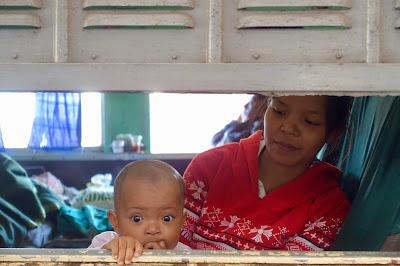Bangkok was never one of my favourite cities. I should admit that I lived here for several months almost 20 years ago but unable to settle, left and returned to London. I waited a long time before going back and then two years ago I spent a few days there on the way home from Myanmar. I wanted to challenge my view of the city and to find a more authentic Bangkok away from the office blocks, malls and hassles.
Last month I was again in Myanmar and decided to spend four nights in Bangkok before coming home. I had enjoyed my stay in 2017 but still felt that I had not found the real Bangkok. In preparation for my visit I read a lot and spent a long time on the internet in the hope that I would leave feeling better disposed towards the city and with a good photographic record of my search. With this in mind I kept away from the "delights" of Silom and Sukhumvit and instead spent my time wandering through Khlong Toei, Thonburi and Chinatown.
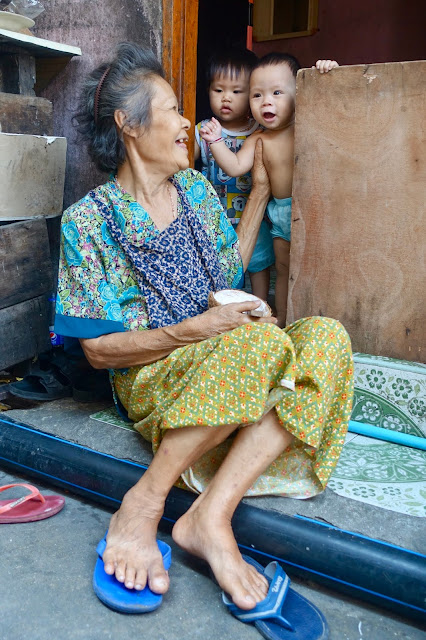 |
| Fun with grandma, Khlong Toei |
Khlong Toei is one of the poorest areas of the city, located on land owned by the Port of Thailand. Many people moved there in the 1950's to take advantage of cheap land rental and to look for work. The rapid growth of the city's population from the 1970's onwards coupled with lack of investment in cheap accommodation meant that the settlement grew into what is now one the largest slums in Bangkok and home to an estimated 100,000 people. The term slum does not do justice to what is an established, seemingly cohesive community where shops, food stalls and other businesses have been established but it stands on low lying swampy land that is prone to flooding during the rainy season. The impact of this is made worse by the fact that many, although by no means not all, of the homes are fragile and make-shift and that there are problems with waste disposal, sanitation and health.
I spent a few hours walking through the neighbourhood and met several of the very friendly and welcoming residents who without exception were happy to talk a little and to be photographed. It helped that I was accompanied by someone based in the city and who has a good command of Thai but also, to my surprise, by my being able to recall rather more of the language than I expected. I have no doubt that that was a tribute to the skills of my teachers from two decades ago rather than any linguistic capability on my part.
 |
| The recycling lady, Khlong Toei |
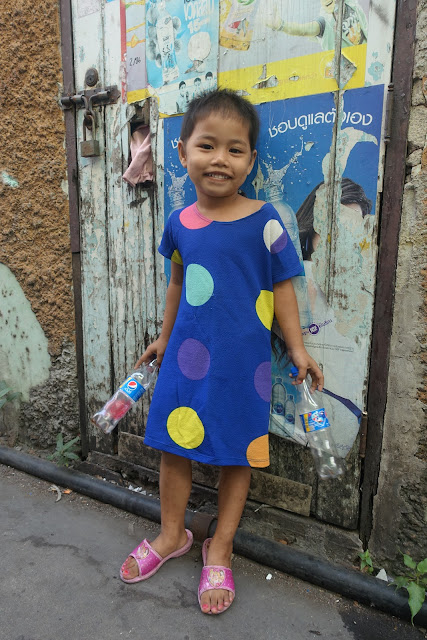 |
| "Be careful where you put your feet" Khlong Toei |
 |
| Friends, Khlong Toei |
Amongst the many people I met was an elderly woman who collects recyclable materials for a living. Not only this, her house is made entirely from recycled items. This reminded me of my experience of traveling in India where in many communities, nothing is wasted and everything is recycled or re-used. It is interesting to see the very practical application of recycling, so different from the seemingly more sophisticated but more bureaucratic and complicated approach at home.
As I visited the Khlong on a weekday, most of the people I met were either elderly or very young. In many cases grandparents were looking after young children whilst their own parents worked. I stopped to say hello to an elderly woman sitting on the step of her home when two very small children appeared behind her, peeping over the safety gate to see who was there. As she turned around to them, a look of absolute delight crossed her face. The happy trio are pictured in the photograph at the top of this post.
Considering the difficulties many of the residents of Khlong Toei face, I encountered many smiles and some moments of humour. A small girl stopped to say hello and to stand for a picture. Whilst I crouched to photograph her she kept trying to tell me something. Too late I realised that she was saying that a dog had left something on the pavement close to my feet. Much to her amusement I had already stepped in it. She laughed again when as I began to move on, she decided to smack me on the behind with one of the two empty plastic bottles she was carrying. A girl with a sense of humour. Further on I came across a trio of boys, probably aged between 7 and 11, all barefoot and holding small toys that they were keen to show me. The smallest one became very excited and began performing a dance routine with some impossible looking stretches, hand stands and a big big smile. And of course, people offered to share their food with me. As ever, the people with the least material wealth seemed to be the most generous.
 |
| I can dance too - Khlong Toei |
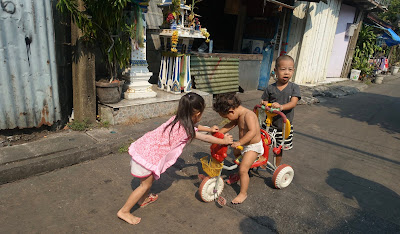 |
| Driving lesson- Khlong Toei |
Khlong Toei is a complicated place. In the heart of one of the biggest cities in the world, parts of it appear almost rural as some residents have tried to beautify their living spaces with plants and small gardens. A railway line runs through one part of the settlement, just a few feet away from people's front doors, but even beside the line there is a sense of peace and quiet during the day and greenery lines the tracks. In addition to efforts made by the locals, a number of organisations have undertaken work there to support the health and well-being of the community. In addition to the daily struggles, another threat hangs over Khlong Toei. The land is extremely valuable. In the centre of the city, it is attractive to developers and would realise enormous sums were it to be sold. From time to time there have been threats of demolition and clearance which would bring this long established community to an end.
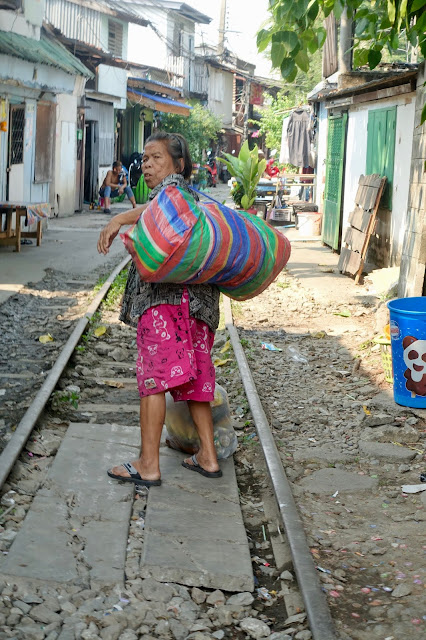 |
| On the lines - Khlong Toei |
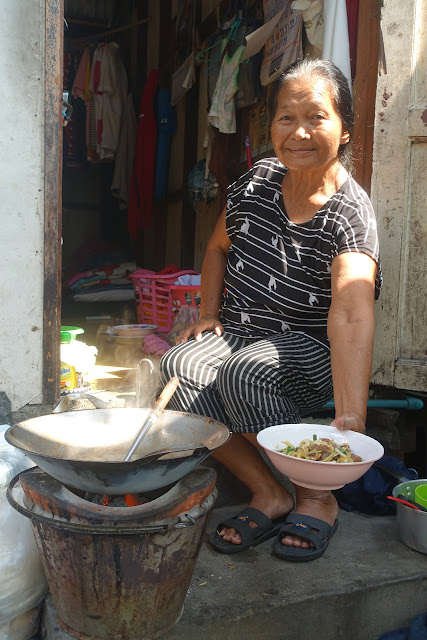 |
| Lunch time, Khlong Toei |
Thonburi is sometimes referred to as being on the "other side" of the Chao Phraya river, away from the busy streets of the main business district. For 15 brief years during the 18th century it acted as the Thai capital after the fall of Ayutthaya and before the establishment of what is now Bangkok. Moving away from the river Thonburi has many narrow streets and lanes lined with local markets, small shops and solid looking homes. Strolling through the neighbourhood it is still possible to see a number of traditional crafts being practiced, such as the making of flutes in the Baan Lao village and several tailoring businesses.
As in Khlong Toei, the residents of Thonburi were happy to be photographed and to talk a little. Some had clearly been photographed before. Passing a tailoring shop I noticed a fabulous floral lace shift dress displayed on a mannequin. A pink appliqué flower completed the look and as I raised my camera to capture it, one of the seamstresses, a Chinese woman, stood up and began to pose beside it, rightfully proud of her work. Fabulous.
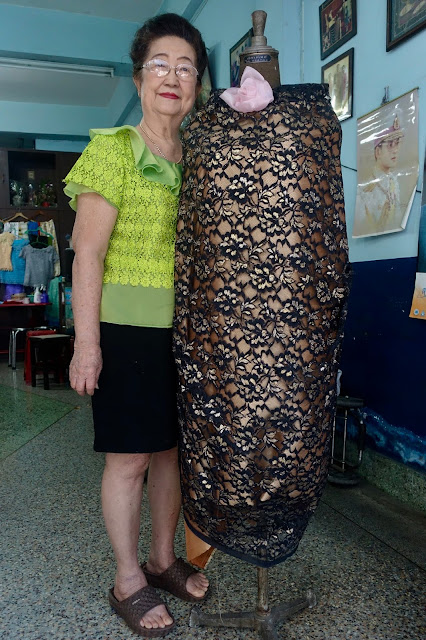 |
| Proud seamstress, Thonburi |
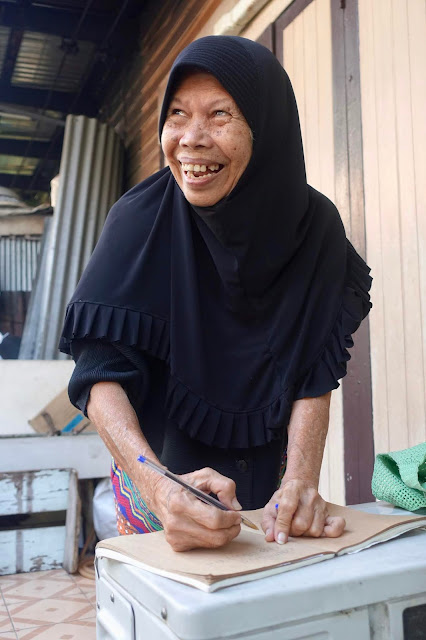 |
| Khun Somnung, Thonburi |
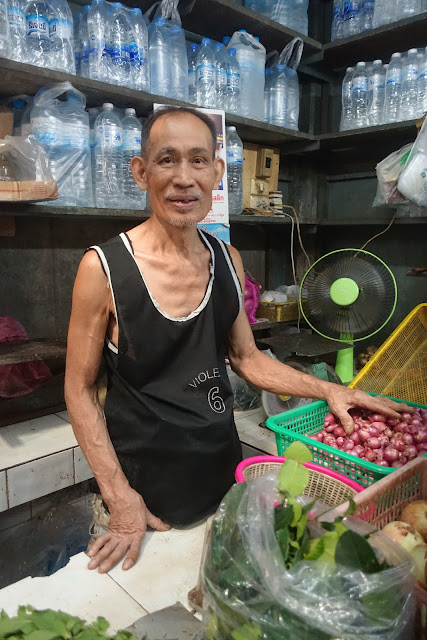 |
| Market vendor, Thonburi |
Thonburi is home to a significant Muslim community and a little further along I met Khun Somnung, an elderly, grey haired lady who saw me looking at a picture of the previous King, displayed on the front of her neighbour's house. The photograph had been taken when he was very young and was studying in Switzerland. She was delighted to tell me all about this and very happy to be photographed. However she took me by surprise when she asked me to wait and produced a hijab from inside her bag, put it on and signalled that she was ready to proceed. Somnung was a great model and knew where and how to stand in relation to the light. She allowed me to take many pictures. My favourite is the one above showing her smiling as she writes her address in my notebook so that I could send some pictures to her. She should have received them by now. I hope she likes them.
Wandering through Thonburi's back lanes, I came across numerous Buddhist temples, including the small but exquisite Chao Mae Aniew Chinese shrine. The doors to the main shrine are stunning examples of Thai/ Chinese craftsmanship, deep red with female figures guarding the entrance. The friendly keeper of the temple opened the doors for me and stood between them for a picture.
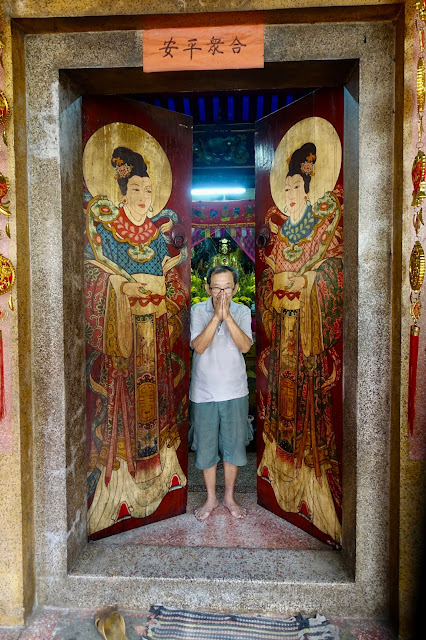 |
| Chao Mae Aniew Shrine, Thonburi |
 |
| Elderly lady relaxing in the shade, Thonburi |
Bangkok's Chinatown was founded in 1782 and is one of the oldest parts of the city. It attracts both locals and tourists who come to shop in the street markets, to eat or to visit one or more of the many temples. I preferred to head for the quieter streets where Art Deco influenced buildings, warehouses, traditional medicine shops and cafes can be found as well as the trendiest of bars, a smattering of boutiques and some interesting street art featuring Chinese calligraphy. There are also a few streets lined with mechanics repair shops where the working class traditions of the neighbourhood linger on.
So do I feel differently about the city? I certainly enjoyed my few days there and am finally convinced that it is much more interesting than I had previously thought. Have I found the real Bangkok? I wouldn't presume to answer that question as I have hardly scratched the surface of Khlong Toei, Thonburi and Chinatown and need to explore them in more detail. I could easily spend a whole day in Khlong Toei's famous market and I have yet to explore the communities that live on the riverside in Thonburi. And of course there will doubtless be other areas that I have yet to discover. I know I will be in Myanmar again which means I should be back in Bangkok too...
And to close, some pictures from Chinatown and my favourite image from Thonburi - friends relaxing in a quiet lane.
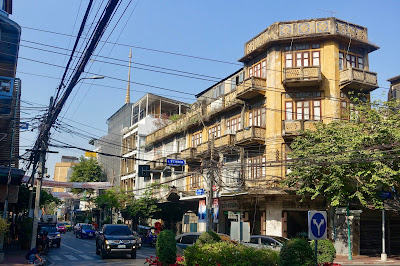 |
| Art Deco influenced building, Chinatown |
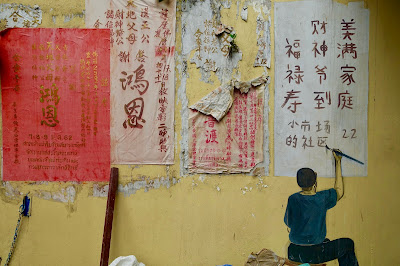 |
| Calligraphy as street art, Chinatown |
 |
| Khun Ooan runs a food stall in Chinatown |
 |
| Archway, Chinatown |
.























